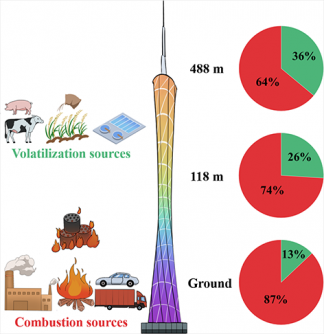BREAKING NEWS: A groundbreaking study by researchers from Jinan University reveals that combustion-related activities are the dominant source of atmospheric ammonia in the Pearl River Delta (PRD), China. This urgent finding comes as air quality concerns escalate in one of the world’s most densely populated regions.
Published in Frontiers of Environmental Science & Engineering, the study highlights the critical role of ammonia (NH3), a precursor to harmful fine particulate matter (PM2.5), in the air quality crisis affecting millions. Researchers conducted a comprehensive analysis, collecting PM2.5 samples from three atmospheric heights—ground level, 118 m, and 488 m—using the Canton Tower, the tallest structure in the PRD, as their observational base.
The results, gathered from extensive sampling campaigns conducted in November 2023, showed average concentrations of ammonium (NH4+) at 2.7 ± 1.4, 3.0 ± 1.8, and 2.6 ± 1.7 μg/m³ across the three heights, indicating no significant difference. However, the research uncovered a significant correlation between the nitrogen isotope composition values in NH4+ and atmospheric height, a crucial insight for understanding pollution dynamics.
Officials confirm that the study reveals critical insights into the sources of ammonia emissions. The analysis indicates that the contributions from various sources at ground level include: agriculture (9.9% ± 4.4%), waste (8.3% ± 5.5%), vehicles (29% ± 8.0%), biomass burning (16% ± 2.2%), ammonia slip (25% ± 6.0%), and coal combustion (12% ± 3.4%).
In contrast, the contributions from sources at the 488 m height remained relatively stable, reflecting the limited influence of local activities. This stark difference emphasizes the urgent need for targeted air quality interventions in urban areas, where emissions from combustion activities are most concentrated.
This study not only sheds light on the atmospheric dynamics of ammonia but also raises pressing questions about public health and environmental policy in the PRD. With air quality deteriorating, the findings are expected to influence local governance and environmental regulations significantly.
Researchers employed the Bayesian Isotope Mixture Model for source apportionment, revealing the intricate network of pollution contributors. The implications are profound: as cities expand, understanding the vertical distribution of pollutants can enhance mitigation strategies and improve air quality for millions.
As discussions about climate change and urban air quality intensify worldwide, this study serves as a critical reminder of the challenges faced by rapidly developing regions. The research underscores the critical importance of reducing emissions from combustion sources to protect public health.
For those interested in the full findings, the study is available at: Frontiers of Environmental Science & Engineering.
The urgency of addressing air quality issues in the Pearl River Delta cannot be overstated. As urban populations grow and industrial activities increase, understanding and tackling the sources of atmospheric ammonia will be vital for the health of residents and the environment.






